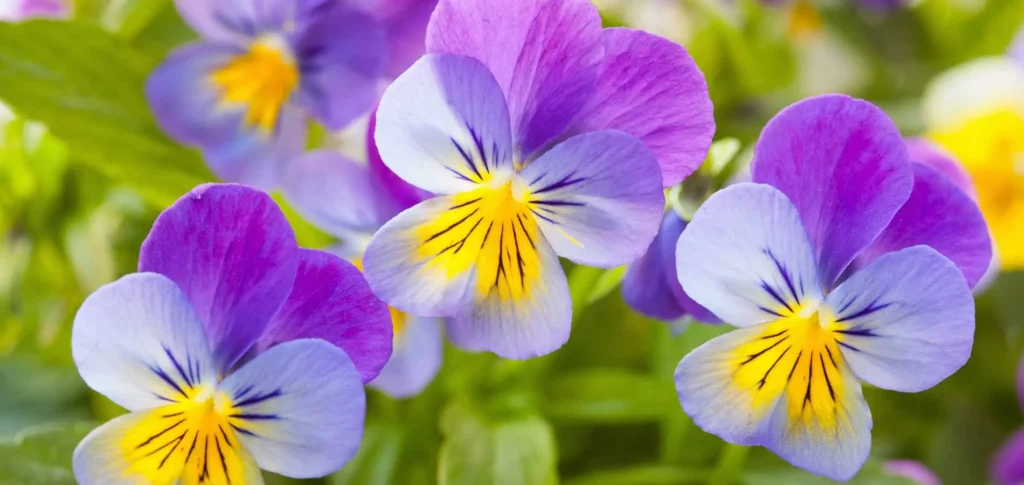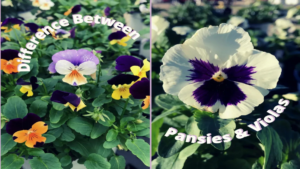Brighten your garden with pansies and violas! Learn planting, care, varieties, and design tips for these charming flowers.
Introduction: Pansies and violas
Pansies and violas are the pop stars of the cool-weather garden. Their cheerful faces and dazzling colors can brighten up any landscape, from crisp fall days right through to early spring. If you haven’t gotten acquainted with these versatile charmers, you’re in for a treat! Let’s dive into the wonderful world of pansies and violas.
What Is The Difference Between Pansies and Violas?
Characteristics of Pansies
Pansies are known for their large, colorful blooms which often feature a distinctive “face.” These flowers typically have four petals pointing upwards and one pointing downwards. Pansies are favored for their bold colors and large petals, making them ideal for a visual impact in garden beds and containers.
Characteristics of Violas
Violas, often referred to as “Johnny-Jump-Ups,” have smaller but more abundant flowers compared to pansies. They feature two petals pointing up and three pointing down. Violas are celebrated for their ability to bloom under cooler temperatures and their sweet, subtle scent1.
Growth and Care
Both pansies and violas thrive in cooler weather, preferring full sun to partial shade. They require well-drained soil and regular watering. While pansies may need more frequent deadheading to prolong blooming, violas tend to be lower maintenance, often reseeding themselves and flourishing in a wider range of conditions.

Are Pansies and Violas Annuals or Perennials?
Pansies and violas are technically perennials but are often grown as annuals, especially in regions with hot summers. In milder climates, they can survive and bloom for multiple seasons if properly cared for. This adaptability makes them versatile additions to seasonal garden displays.
How Long Do Pansies and Violas Bloom?
Bloom Duration
Pansies typically bloom from early spring through late fall, depending on the climate. In cooler regions, they can even provide color through mild winters. Violas have a similar bloom period but are more likely to continue blooming through winter, especially in milder climates.
Maximizing Bloom Time
To extend the blooming period, regular deadheading of spent flowers is crucial. Providing a balanced fertilizer can also encourage more robust blooms. For both pansies and violas, ensuring they are not exposed to extreme heat will help prolong their display.
How to Work Pansies and Violas Into Your Landscape
Garden Beds and Borders
Pansies make excellent borders with their larger blooms, while violas are perfect for filling in gaps with their abundant smaller flowers. Both can be used effectively under shrubs or trees, providing a splash of color in shaded areas.
Containers and Hanging Baskets
Both flowers excel in containers. Pansies, with their larger blooms, are great for focal points. Violas, due to their trailing habit, are ideal for hanging baskets where their flowers can cascade over the edges.
When Do Violas Bloom?
Violas are incredibly resilient and can start blooming early in the spring, continuing through late fall. In some regions, they can even bloom throughout the winter, making them excellent for year-round garden interest.
What Are Violas’ Cold Tolerance?
Violas are known for their exceptional cold tolerance. They can often withstand freezing temperatures and continue to bloom, making them ideal for fall and winter gardening in many climates.
Are Violas the Same as Pansies?
While both belong to the Viola family, they are not the same. Violas tend to have smaller, more numerous flowers and a higher tolerance for cold weather. Pansies, with their larger, fewer blooms, make more of a statement but are less cold-hardy.
Conclusion
Pansies and violas offer a delightful range of colors and sizes for any gardener looking to brighten their landscape. Understanding the differences between these two plants and how to care for them can help you enjoy their beauty to the fullest. Whether you choose the bold pansies or the resilient violas, both are sure to add charm and color to your garden.
FAQs
A: Yes, both pansies and violas can survive light frosts. Violas, in particular, are known for their ability to withstand colder temperatures.
A: Water pansies and violas regularly to keep the soil moist but not soggy. They thrive with consistent moisture, especially during dry periods.
A: Yes, both pansies and violas are edible and can be used to add color and a mild flavor to salads and desserts.

Somebody essentially lend a hand to make significantly articles Id state That is the very first time I frequented your website page and up to now I surprised with the research you made to make this actual submit amazing Wonderful task
I’m really glad to hear that my article helped you feel hopeful!
Ny weekly Pretty! This has been a really wonderful post. Many thanks for providing these details.
I’m really glad to hear that my article helped you feel hopeful!
obviously like your website but you need to test the spelling on quite a few of your posts Several of them are rife with spelling problems and I to find it very troublesome to inform the reality on the other hand Ill certainly come back again
I’m really glad to hear about my article.
I just could not depart your web site prior to suggesting that I really loved the usual info an individual supply in your visitors Is gonna be back regularly to check up on new posts
I’m really glad to hear that my article helped you feel hopeful!
Strands Hint For the reason that the admin of this site is working, no uncertainty very quickly it will be renowned, due to its quality contents.
Thank you for your feedback! I’m glad you enjoyed the content and found it engaging
FinTechZoomUs There is definately a lot to find out about this subject. I like all the points you made
Thank you for your feedback! I’m glad you enjoyed the content and found it engaging
Thank you for your feedback! I’m glad you enjoyed the content and found it engaging.
I do not even know how I ended up here but I thought this post was great I dont know who you are but definitely youre going to a famous blogger if you arent already Cheers